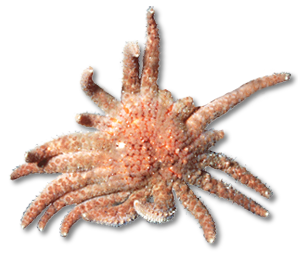Research Study 1

Fig. 1. Neither defensive strategy seems to have worked for this Evasterias troschelii, being consumed by a Solaster dawsoni
Responses of prospective prey species Evasterias troschelii and Pycnopodia helianthoides as observed in San Juan Islands, Washington to the "asteroidivorous" sun star Solaster dawsoni (Fig. 1) includes running away and autotomising arms.
Mauzey et al. 1968 Ecology 49: 603
Research Study 2

Fig. 1. Sunflower star Pycnopodia helianthoides in a tidepool, with missing arm. The loss may have been caused by being buffeted about in the intertidal zone, rather than autotomy, because the wound looks quite rough and the autotomy plane in Pycnopodia is usually closer to the disc

Fig. 2. Autotomised arm of Pycnopodia helianthoides crawling about after being detached

Fig. 3. Autotomised arm of a rainbow star Orthasterias koehleri being consumed by scavenging whelks Lirabuccinum dirum
Anyone who has handled sunflower stars Pycnopodia helianthoides (Fig. 1) will be familiar with their propensity to drop arms. This can result from exposure to warm seawater temperatures or physical stimulation, and is thought to involve transformational changes in “catch” connective tissue. If coelomic fluid from an arm-dropping specimen is injected into an resting Pycnopodia, the latter will proceed to drop its arms. Fluids from unstimulated control individuals do not similarly induce autotomy. Fractionation columns yield a substance of 1200 Daltons that induces autotomy in control individuals in < 1min. As the activity of this substance is lost on heating or treatment with a protease, the authors consider it likely to be a peptide. Autotomy is thought to be an anti-predator strategy because a predator initiating arm-loss in an intended prey may be distracted by the autotomised arm and even begin to feed on it (see Fig. 2). Note that the autotomised arm in this photo appears otherwise to be quite healthy. This leaves the arm’s previous owner free to move away to safety. Also, by dropping a damaged arm the sea star may minimise the chance of infection and reduce leakage of possible predator-attracting metabolites. Autotomy sites themselves seem never to become infected and the lost arms usually crawl around for a few days. However, without a mouth they are unable to feed, and soon run out of energy and die (Fig. 3).
NOTE more on this subject can be found in SEA CUCUMBERS>PREDATORS & DEFENSES>HIDING/ ”CATCH” CONNECTIVE TISSUES
NOTE measure of mass of a molecule = 1/12th the mass of a C atom
Mladenov et al. 1988 In, Echinoderm Biology (Burke et al., eds) AA Balkema, Rotterdam
Research Study 3

Fig. 1. Ossicles in the arm of Pycnopodia helianthoides

Fig. 2. Arrangement of muscles and ligaments holding arm ossicles together in Pycnopodia helianthoides
In times of duress, sunflower stars Pycnopodia helianthoides may autotomise one, some, or all of their arms. The arms are always shed at their bases. To understand how the process works, visualise how the arm is held together. Two rows of ambulacral ossicles run down the length of each arm (see Fig. 1). The ossicles are held together by ligaments and muscles (Fig. 2). Severance involves first a loss of tensile strength in the arm ligaments, followed by rupture of the arm muscles and separation of adjacent ossicles at the autotomy point.
NOTE lit. “self cut” G.
NOTE the process is initiated through nerves being stimulated by secretion of a special “Autotomy-Promoting Factor” or APF. APF is thought to be a small peptide molecule. APF can be chemically isolated and, when injected into another Pycnopodia, will cause multiple arm loss
Wilkie et al. 1995 In, Echinoderm Research (Emson et al., eds) AA Balkema, Rotterdam
Research Study 4

Fig. 1. Leptasterias hexactis brooding its eggs

Fig. 2. Long-terms costs to reproduction in Leptasterias hexactis of varying extents of arm loss through autotomy
Field observations of Leptasterias hexactis in Puget Sound, Washington disclose that 30-46% of individuals are missing arms or parts of arms. This may result from wave action and resultant shifting rocks, or from predators. With respect to the last, laboratory tests with 6 common intertidal crab species show that at least one, Cancer oregonensis, could have caused the arm-tip nibbling type of damage observed in field animals. Loss of an arm or part of an arm by a sea star may save it from death, but costs of regeneration and decreased foraging are not the only possible consequences. Reproductive output may also be affected because the gonads are located in the arms and, with each arm lost, brooding efficacy would theoretically be reduced by 1/6th, or 17% (Fig. 1). The actual value could be even more because 1/6th of an individual’s digestive capability would also be lost with each missing arm. Indeed, the study shows that reproduction in damaged female Leptasterias hexactis decreases by 44-69%, directly related to the number of arms missing, during the first reproductive season after arm loss (see Fig. 2). Note that effects are expressed even through the following reproductive season, 19mo after arm loss.
Bingham et al. 2000 Can J Zool 78: 596








 Sea stars
Sea stars